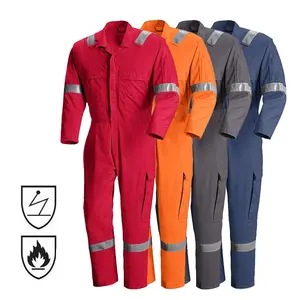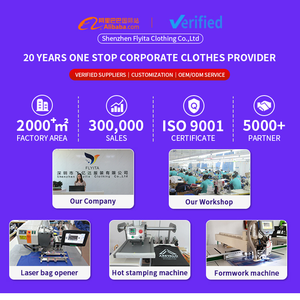
All categories
Featured selections
Trade Assurance
Buyer Central
Help Center
Get the app
Become a supplier

(23992 products available)







































Work clothes for construction are categorized according to the protection they provide and the kind of work performed. Here are their various types:
General Labor Work Clothes
These garments are suitable for light construction work. They include T-shirts, long-sleeve shirts, pants, and jeans. Made from cotton or blended fabrics, they offer comfort and breathability. Specific general labor work clothes include:
Shirts
These tops can be short or long-sleeved, and their material can be cotton, polyester, or a blend. They keep workers cool and protect their skin from the sun.
Pants
They are durable and come in different materials like denim and canvas. They shield the legs and are suitable for rough environments.
Coveralls
These one-piece garments provide full-body protection. They are ideal for messy or hazardous tasks. They protect against dirt, stains, and minor hazards.
Footwear
Work boots are the most common type of footwear. They provide support and protection. Steel-toe boots guard against falling objects. Waterproof boots are suitable for wet conditions.
Head Protection
Hard hats shield from head injuries. They are essential on all construction sites. They come in different classes for specific hazards.
Hand Protection
Gloves protect the hands from cuts, chemicals, and heat. Leather gloves are suitable for heavy tasks. They provide a good grip and shield against abrasions.
Heavy-Duty Work Clothes
These garments are suitable for tough jobs. They are made from strong materials like denim and canvas. They can withstand wear and tear. They include:
Durable Fabrics
These fabrics are strong and resilient. They include cotton, polyester, and nylon blends. They resist abrasion and extend the life of work clothes.
Reinforced Seams
These seams are double-stitched or bar-tacked. They prevent splitting and ensure longevity. They are common in heavy-duty work clothes.
Functional Pockets
Pockets are designed to hold tools and accessories. They improve functionality and make tools accessible. They are found in vests, jackets, and pants.
Adjustable Features
These features provide a better fit and flexibility. They include cuffs, waistbands, and hood drawstrings. They accommodate layers and different body types.
High Visibility Options
These clothes enhance safety in low-light conditions. They incorporate reflective stripes. They are essential for night work and near traffic.
Specialized Work Clothes
These garments are tailored for specific roles. They meet unique safety and function requirements. They include:
Chemical-Resistant Clothing
These clothes protect against harmful substances. They are made from PVC, rubber, or treated fabrics. They are essential in hazardous environments.
Fire-Resistant Clothing
These garments shield workers from fire hazards. They are made from specialized fabrics. FR cotton and Nomex are common materials. They are vital in welding and electrical work.
Cold Weather Gear
These clothes keep workers warm in cold climates. They include insulated jackets, pants, and gloves. They use materials like down and synthetic fibers. They are essential for outdoor work in winter.
Heat-Resistant Clothing
They protect against heat and sparks. They are suitable for foundry work or near open flames. They use materials like leather and aluminized fabrics.
Construction work clothing is designed with various essential elements in mind. First, the fit should be comfortable and allow for a full range of motion without being too loose. This is especially important for garments like shirts, pants, and jackets, which should not restrict movement but also fit properly to avoid snagging on tools or equipment.
Layering is another crucial consideration. Construction workers often face varying weather conditions, so having clothing that layers well is important. Base layers should wick moisture away from the body, mid-layers should provide insulation, and outer layers should be wind and waterproof. Each layer should fit well on its own but also work together without bulk or restriction of movement.
Durability is a key characteristic of construction work clothes. They should be able to withstand wear and tear from physical labor and exposure to different elements. Reinforced seams, sturdy fabrics like canvas or heavy-duty cotton, and well-constructed garments are vital for longevity and reliability in a construction environment.
Lastly, attention to detail in construction work clothing design can enhance functionality. Pockets should be strategically placed and sized to hold tools, mobile devices, and personal items without hindering movement or balance. Reflective strips and safety features are important for visibility and protection in hazardous environments. Overall, thoughtful design elements contribute to the practicality and effectiveness of construction work clothes for a demanding job.
Fabric and Material
The material from which construction work clothing is made is the most important design element. It dictates the level of comfort, protection, and durability the garment can provide. Natural fibers like cotton are comfortable but may not be as durable or water-resistant as synthetic materials like polyester or nylon. Blends of different fibers can offer a balance of comfort and durability. For instance, a cotton-polyester blend can provide breathability while resisting wear and tear. Additionally, fabrics treated with waterproof or windproof coatings offer protection against the elements, making them suitable for outdoor construction work.
Fit and Comfort
The fit and comfort of construction work clothing are crucial for ensuring that workers can perform their tasks effectively. Garments that fit well allow for a full range of motion, which is essential for physical labor. Loose clothing can snag on tools or machinery, posing safety risks. Therefore, clothing designed specifically for construction often features a tailored fit that accommodates movement without being restrictive. Adjustable elements like elastic cuffs, drawstrings, and Velcro straps can further enhance the fit, allowing workers to customize how the garment sits on their bodies. Additionally, ergonomic design features, such as articulated knees in work pants or gusseted underarms in shirts, enhance mobility in specific areas where extensive movement is expected.
Functionality and Features
Construction work clothing is designed with various functional features that enhance its practicality. Pockets are one of the most important additions, as they allow workers to carry tools, equipment, and personal belongings. Garments designed for construction often include multiple pockets, including tool pockets, cargo pockets, and hidden pockets for secure storage. Reinforcements in high-wear areas like the knees, elbows, and seams extend the garment's lifespan and provide additional durability. Reflective strips and safety features are critical for visibility and protection in hazardous environments. Additionally, some work clothing includes built-in insulation or liners for added warmth during colder weather, making them versatile for different seasons and conditions.
Wearing and matching construction work clothes requires attention to functionality, comfort, and safety. Here are some suggestions:
Layering for Versatility
Layering is an ideal way of matching construction work clothing. A t-shirt or a thermal long-sleeve top can be matched with a hoodie, sweatshirt, or fleece jacket. This combination provides flexibility for changing weather conditions. A work jacket or heavy-duty work coat can be added for extra warmth. Layering allows for easy adjustments throughout the day. It ensures comfort and maintains productivity in varying temperatures on the construction site.
Footwear Coordination
When choosing footwear, select shoes that are comfortable and safe for construction work. Steel-toed boots provide protection and support the feet for long hours of standing. Waterproof boots are ideal for outdoor work in wet conditions. Consider the type of work being performed and choose boots that offer the necessary safety features without compromising comfort. Properly fit the work gloves to ensure dexterity and grip. Choose gloves made from durable materials that offer protection without sacrificing flexibility. Different tasks require different glove types. For example, general-purpose gloves work well for most tasks, while specialized gloves are needed for handling hazardous materials or operating power tools.
Color Coordination for Safety
Choose work clothes in high-visibility colors like neon yellow, orange, or lime green. These colors enhance visibility and safety on the construction site. Pair high-visibility vests with neutral-colored pants or shorts. This combination ensures visibility without compromising professionalism. Opt for light-colored work shirts in summer. Light colors reflect heat and keep the body cooler. Dark-colored clothes may absorb more heat and cause discomfort during hot weather. Combine light-colored tops with dark-colored pants to maintain a balanced and practical outfit. Dark colors also hide dirt and stains better in messy construction environments.
Functional Accessories
Accessorize construction work clothes with functional items that enhance comfort and safety. Hard hats should be adjusted for a secure fit. They should meet safety standards and provide adequate protection. Safety glasses should fit well and offer clear vision. Look for glasses with anti-fog and scratch-resistant coatings. Work belts or tool pouches should be worn to keep essential tools and supplies within reach. Select belts with adjustable fittings and durable construction. Consider tool pouches with multiple pockets for organization. These accessories improve efficiency and ensure readiness for various tasks throughout the day.
Choosing the Right Fabrics
When selecting work clothes, choose fabrics that offer breathability and durability. Cotton blends provide comfort and moisture-wicking properties. They keep the body dry and cool. Polyester blends enhance durability and resistance to wrinkles and shrinking. They maintain a polished appearance throughout the day. Heavy-duty denim work shirts provide excellent durability and withstand wear and tear. They offer a rugged and long-lasting option for construction work. Canvas work pants are another excellent choice for their strength and flexibility. Canvas is a sturdy fabric that allows for ease of movement while providing protection and durability.
Q1: What is the importance of work clothes in construction?
A1: Work clothes in construction are vital for safety, comfort, and functionality. They protect workers from hazards like chemicals, sharp objects, and extreme weather. Well-designed work clothing enhances mobility and efficiency, allowing workers to perform their tasks safely and effectively.
Q2: What are the essential features of effective construction work clothes?
A2: Effective construction work clothes should have safety features like high visibility and flame resistance. They must be durable, made from robust materials that withstand wear and tear. Comfort is crucial, with ergonomic design and breathability for long work hours. Versatile and weather-resistant properties are also essential.
Q3: How do different construction trades influence work clothing choices?
A3: Different construction trades have unique requirements that influence work clothing choices. For example, electricians need flame-resistant clothing, while carpenters require durable and flexible attire. Each trade's specific hazards and tasks dictate the necessary safety features and functional design of work clothes.
Q4: What materials are best for construction work shirts and why?
A4: The best materials for construction work shirts include cotton, polyester, and blends. Cotton offers breathability and comfort, polyester provides durability and moisture-wicking properties, and blends combine the advantages of both. These materials ensure comfort and longevity, essential for demanding construction environments.
Q5: How do weather conditions affect work clothes construction?
A5: Weather conditions significantly impact work clothes construction. In cold weather, layered, insulated, and wind-resistant clothing is essential. Hot weather calls for lightweight, breathable, and moisture-wicking fabrics to keep workers cool. Rainy conditions require waterproof and weather-resistant materials to ensure protection and comfort.